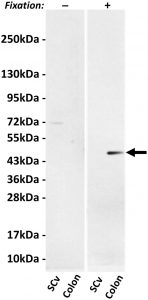Choline acetyltransferase (ChAT), the enzyme synthesizing acetylcholine (ACh), has an exon-skipping splice variant which is expressed preferentially in the peripheral nervous system (PNS) and thus termed peripheral ChAT (pChAT). A rabbit antiserum beforehand produced towards rat pChAT (rpChAT) has been used for immunohistochemistry (IHC) to research peripheral cholinergic buildings in numerous animals. The current research was undertaken to develop a particular antiserum towards a predicted human pChAT (hpChAT) protein. A novel mouse antiserum has been efficiently raised towards a distinctive 14-amino acid sequence of hpChAT protein.
Our Western blot utilizing this antiserum (termed right here anti-hpChAT serum) on human colon extracts revealed solely a single band of 47 kDa, matching the deduced measurement of hpChAT protein. By IHC, the antiserum gave intense staining in many neuronal cells and fibers of human colon however not mind, and such a sample of staining appeared equivalent with that reported in colon of assorted animals utilizing anti-rpChAT serum. In the antibody-absorption check, hpChAT-immunoreactive staining in human colon was fully blocked through the use of the antiserum pre-absorbed with the antigen peptide.
Double immunofluorescence in human colon furthermore indicated that buildings stained with anti-hpChAT had been additionally stained with anti-rpChAT, and vice versa. hpChAT antiserum allowed the identification of cell varieties, as Dogiel kind cells in intramural plexuses, and fiber innervation of colon muscle tissue and mucosae. The current outcomes display the specificity and reliability of the hpChAT antiserum as a novel instrument for immunohistochemical research in human colon, opening venues to map cholinergic innervation in different human PNS tissues.

A Novel Antiserum Against a Predicted Human Peripheral Choline Acetyltransferase (hpChAT) for Labeling Neuronal Structures in Human Colon.
Analysis of agglutinants elicited by antiserum of channel catfish immunized with extracellular proteins of virulent Aeromonas hydrophila.
Motile Aeromonas septicemia (MAS), attributable to new virulent Aeromonas hydrophila (vAh) strains, has been one of many main illnesses in channel catfish in current years. Previous research confirmed that channel catfish developed immunity towards vAh an infection after immunization with the pathogen’s extracellular proteins (ECP). To perceive the mechanisms related to the immunity, anti-ECP fish serum (antiserum) was analyzed in this research. Our outcomes revealed that the antiserum elicited agglutination of each ECP and cells of vAh. Five fish proteins had been recognized in ECP agglutinants, together with two innate immunity related proteins (serotransferrin and rhamnose-binding lectin), two immunoglobulin M (IgM) molecules (IgM heavy chain and lightweight chain) and a constitutively-produced protein (heat temperature acclimation protein). More than 68 vAh proteins in ECP had been acknowledged and precipitated to combination by IgM in the antiserum. IgM was remoted from vAh cell agglutinants and the native IgM was proven to kind a tetramer that was accountable for bacterial agglutination.
[Linking template=”default” type=”products” search=”choline” header=”1″ limit=”120″ start=”2″ showCatalogNumber=”true” showSize=”true” showSupplier=”true” showPrice=”true” showDescription=”true” showAdditionalInformation=”true” showImage=”true” showSchemaMarkup=”true” imageWidth=”” imageHeight=””]
Immunoblotting evaluation indicated that the remoted native IgM was capable of acknowledge some proteins in ECP, comparable to aerolysin and hemolysin (in the type of a excessive molecular weight heterologous polymer). Gene expression evaluation by quantitative PCR confirmed that fish immunized with vAh ECP had extra transcripts of genes coding for IgM, serotransferrin and rhamnose binding lectin than mock-immunized fish. Both innate and antibody-mediated immune responses in serum and expressed genes contributed to fish immunity upon immunization with ECP. Results of this research make clear the flexibility of vAh antigens and catfish IgM, which might assist determine particular antigens for vaccine growth and antigen particular antibodies in catfish.
